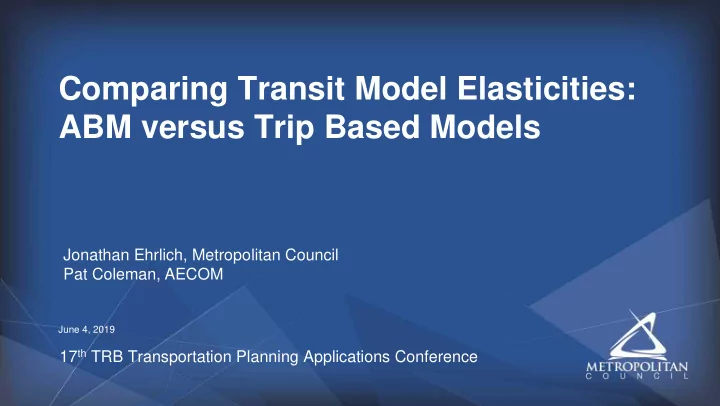

Comparing Transit Model Elasticities: ABM versus Trip Based Models Jonathan Ehrlich, Metropolitan Council Pat Coleman, AECOM June 4, 2019 17 th TRB Transportation Planning Applications Conference
Overview • Project Description • Model Overview • Tour versus Trip Based Forecast Example • Elasticity Tests • Findings 2
Project Description • Test new ABM’s ability to forecast projects • Understand the differences forecasts between the ABM and older trip-based model • 4 corridors compared • Recommended changes to ABM to improve forecasts • Worked closely with Model Developer • Elasticity tests part of project 3
Model Overview • Uses Tourcast suite of programs for long term, tour, and stop/trip level generation and choices • CUBE used for path and network procedures • “Consistent tours” procedure developed for transit forecasts 17 th TRB Transportation Planning Applications Conference 4
Tour vs. Trip Based Forecasts Trips on the New Riders Project Trip Based 5,200 2,300 Model ABM 2,000 400 • Proposed “Robert Street” LRT Line from downtown St. Paul to the south 17 th TRB Transportation Planning Applications Conference 5
Elasticity Test #1:In-Vehicle Time • Test elasticity of Trip-based versus ABM models • Multiply the in-vehicle travel time in transit skims by a factor of 0.95 for walk to transit and drive to transit skims • Elasticities determined using incremental change in transit trips (Trip-Based Model) or tours (ABM) • Additional comparison made to a “benchmark model” – -0.025 in-vehicle time coefficient – 2.5 OVT/IVT ratio 17 th TRB Transportation Planning Applications Conference 6
Test #1 : In-Vehicle Time Trip-Based Model ABM 0.31 Work 0.26 0.38 HBW 0.62 0.18 University 0.29 0.28 HBWR 0.11 School 0.4 0.22 0.19 0.19 INM|SocialRec HBSCH 0.38 0 0.12 INM|Shopping 0.44 0.66 HBU 1.37 0.12 INM|PerBus 0.2 0.09 HBSH 0.15 INM|Meal 0.1 0 0.26 0.19 HBO FJNMT|SocialRec 0 0.36 0.24 FJNMT|Shopping 0.31 0 NHBO 0.29 0.1 FJNMT|PerBus 0 0.48 NHBW 0.15 0.49 FJNMT|Meal 0 0.36 ALL PURPOSES 0.2 ALL PURPOSES 0.69 0.26 Walk to Transit Drive to Transit Walk to Transit Drive to Transit (Absolute Values) 17 th TRB Transportation Planning Applications Conference 7
Test #1 : In-Vehicle Time Walk to Transit Drive to Transit 0.62 0.38 HBW/WORK HBW/WORK 0.26 0.31 0.69 0.36 ALL PURPOSES ALL PURPOSES 0.26 0.2 Trip-Based Model ABM Trip-Based Model ABM BENCHMARK MODEL ELASITICITY IS 0.4 (Absolute Values) 17 th TRB Transportation Planning Applications Conference 8
Elasticity Test #2 : Headways • 75% reduction in LRT headways • Reduced coded headway (0.25 x headway) in line file • Elasticities determined using incremental change in transit tours (ABM) • Only tested for ABM as an attempt at modal bias 17 th TRB Transportation Planning Applications Conference 9
Test #2 : Headways ABM 0.01 Work 0.91 0.09 University 0.05 0.04 School 0.03 0.05 INM|SocialRec 0.19 0.03 INM|Shopping 0.13 0.04 INM|PerBus 0.03 0.04 INM|Meal 0 0.07 FJNMT|SocialRec 0 0.09 FJNMT|Shopping 0 0.05 FJNMT|PerBus 0 0.02 FJNMT|Meal 0 0.01 ALL PURPOSES 0.84 Walk to Transit Drive to Transit (Absolute Values) 17 th TRB Transportation Planning Applications Conference 10
Findings • ABM’s ability to generate new transit trips is limited by: – Shallow transit nests in the tour and trip mode choice models (only walk and drive to transit) – Run time factors in path building being the primary way to differentiate transit modes – Large constants further contributed to lower elasticities • Elasticity tests confirmed findings 11
Thanks! • Project Management Team: Mark Filipi, Rachel Wilken, Mike Mechtenberg, Kyle Burrows, Jim Henricksen • Project Advisory Panel: Ken Cervenka, Joe Castiglione, Lee Cryer, Guy Rousseau • Model Developer: Cambridge Systematics • Other Project Team Members: Andrew Walker, Dave Schmitt, Srikanth Neelisetty 12
Thanks! Questions? 13
Recommend
More recommend